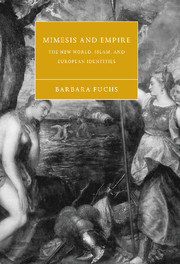Book contents
- Frontmatter
- Contents
- Acknowledgments
- Note on translations
- Introduction
- 1 Truth, fictions, and the New World
- 2 Literary loyalties, imperial betrayals
- 3 Lettered subjects
- 4 Virtual Spaniards
- 5 Faithless empires: pirates, renegadoes, and the English nation
- 6 Pirating Spain
- Conclusion: Contra originality
- Notes
- Bibliography
- Index
- Cambridge Studies in Renaissance Literature and Culture
Conclusion: Contra originality
Published online by Cambridge University Press: 22 September 2009
- Frontmatter
- Contents
- Acknowledgments
- Note on translations
- Introduction
- 1 Truth, fictions, and the New World
- 2 Literary loyalties, imperial betrayals
- 3 Lettered subjects
- 4 Virtual Spaniards
- 5 Faithless empires: pirates, renegadoes, and the English nation
- 6 Pirating Spain
- Conclusion: Contra originality
- Notes
- Bibliography
- Index
- Cambridge Studies in Renaissance Literature and Culture
Summary
Scratch a Russian and you find a Tartar. Scratch a Spaniard and you find a Saracen.
Gertrude Stein, Everybody's Autobiography¡Si parecen españoles!
Fernando Trueba, La niña de tus ojos.In our post-romantic era, we still assign disproportionate value to originals – this, we feel, makes us discriminating critics and connoisseurs. The legacy of romanticism also encourages us to think of resistance – especially cultural resistance – as an original gesture that upends established hierarchies. My larger aim in this project has been to question the privileging of originality by suggesting how closely it is tied to exclusion and political discrimination. I have argued instead for a revaluation of imitation as a cultural and political practice that challenges established national narratives. The early modern confrontations that I have traced throughout suggest that the most interesting mode of resistance to orthodox ideologies of exclusion may often be imitation with a difference. In the face of repressive attempts at homogenization, a calculated deployment of similarity often proves more effective, and more strategically feasible, than the defense of difference.
Mimesis poses a particular challenge to early modern national and imperial identities predicated on exceptionalism and ethnoreligious homogeneity. In the first place, similarity bridges the divide between self and Other. Where ideologies of difference seek to solidify distinctions, mimesis recalls underlying likenesses. Moreover, it undermines the original by showing how easily it can be reproduced, despite claims to singular entitlement.
- Type
- Chapter
- Information
- Mimesis and EmpireThe New World, Islam, and European Identities, pp. 164 - 166Publisher: Cambridge University PressPrint publication year: 2001



